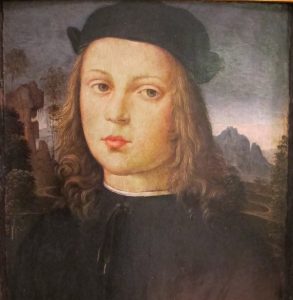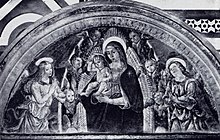Alfonso of Aragon
Alfonso of Aragon (* 1481 in the Kingdom of Naples , † August 18, 1500 in Rome ), Duke of Bisceglie , Prince of Salerno , was an illegitimate son of King Alfonso II of Naples and his mistress Trogia Gazzela. He was Lucrezia Borgia's second husband .
Life
Childhood and youth
Alfonso came from the House of Trastámara through his father Alfons II . According to his family tradition, he received an excellent humanistic education. His first teacher was Giuniano Maio from the Accademia Pontaniana . He was later trained by the Florentine writer Raffaele Brandolini (known as "Lippus Brandolinus" because of his blindness). Alfonso kept in touch with Brandolini even later when they both lived in Rome.
Alfonso has been confronted with the crises that hit his dynasty since he was a child. During the French occupation, his father fled to Sicily in 1495 , where he died shortly afterwards. Alfonso fought for the return of his half-brother Ferdinand II of Naples to the throne, who however died only a year after the accession to the throne. His successor Friedrich I , Uncle Alfonsos, gave him his first offices, so in 1497 Alfonso was appointed lieutenant general in Abruzzo .
marriage
Pope Alexander VI sought a marriage of his daughter Lucrezia with Alfonso in order to bind himself more closely to Naples. Alfonso's sister Sancha was already married to Jofré Borgia , and Cesare Borgia was to marry Charlotte of Aragon, the daughter of King Frederick of Naples. When Alfonso presented himself in Rome, he was described as "the most beautiful young person who had ever been seen in Rome".

The wedding was celebrated on July 21, 1498 in the presence of the family in the Vatican. Alfonso brought the cities of Salerno, Quadrata and Bisceglie into the marriage, Lucrezia a dowry of 40,000 ducats. As part of the agreements, it was specified that the couple would stay in Rome for at least a year and not reside permanently in the Kingdom of Naples until the Pope's death. According to all evidence, Lucrezia really loved her husband. On November 1, 1499, Lucrezia gave birth to their son Rodrigo. He was baptized by Cardinal Carafa on November 11th in the Chapel of Sixtus in St. Peter .
Tried escape from Rome
The international politics of the Borgia changed quickly: Naples was no longer of interest, Cesare pursued a pro-French policy by marrying Charlotte d'Albret. Alfonso was concerned about the Pope's alliance with France. Since he no longer felt safe in Rome, Alfonso secretly left the city on August 2, 1499 and his sixth month pregnant wife to retreat to the Colonna territories and later to Naples. In Genazzano he wrote to his wife so that she might succeed him. However, the letter fell into the hands of Alexander VI. The Pope sent the Spanish captain Giovanni Cervillon to the Neapolitan King Frederick to negotiate Alfonso's return. It was determined that he should meet his wife, this happened on September 19, 1499 in Spoleto . On September 23, they went to Nepi , whose castle belonged to the Pope, where Alexander VI. she expected herself. On October 14th they returned to Rome, where their son Rodrigo was born on November 1st.
First raid
On July 15, 1500, Alfonso visited his wife and sister Sancha and had dinner with his father-in-law. When he left the Vatican he was accompanied by Tommaso Albanese and a groom. He was attacked near the Palazzo di Santa Maria in Portico. Alfonso defended himself, but suffered wounds on his head, back and leg. Meanwhile his groom called for help and tried to pull the bloodied body of his master away in the direction of the Palazzo di Santa Maria in Portico, but when he realized that he was in danger, he pulled it in the direction of the Vatican.
Albanese covered the retreat. Fortunately, the gates of the papal palace opened in time and the papal guard drove the attackers to flight. Contemporaries reported that Alfonso of Aragon was covered in blood on the soldiers' arms, torn and pale as death was carried to the door of the room where Lucrezia was still talking to her father and Sancha. Alfonso announced his attacker with his last breath, and his wife passed out.
After the assassination, Alfonso stayed in the first room of the apartment in the Borgia tower, which was decorated with frescoes by Pinturicchio. Lucrezia and Sancha slept on makeshift beds next to the wounded man, helped him and prepared food themselves on the stove so that he could not be poisoned. In front of the room stood guards, the Pope's doctors and Alfonso's few confidants, and soon there were also ambassadors from King Frederick of Naples, as well as two well-known Neapolitan doctors, Messere Galiano de Anna, surgeon, and Messere Clemente Gactula, doctor. Alfonso recovered noticeably from the treatments and probably also from his youthful strength.
Cesare Borgia visited his brother-in-law and is said to have whispered that the things that didn't work out at lunch would work out at dinner . Lucrezia, feeling the danger her husband was in, had agreed with King Friedrich that Alfonso should leave for Naples as soon as he could travel and wanted to accompany him himself or to follow him later. It was widely rumored that the mastermind behind the assassination attempt was Cesare Borgia, who wanted to politically marry his sister again. These assumptions were confirmed by an episode when the Venetian envoy on Pope Alexander VI. met. After lengthy negotiations about his son's innocence, he is said to have finally declared that if Cesare was behind the attack, this would only be a sign that Alfonso deserved it.
The Orsini were among the suspects , as Alfonso sympathized with the Colonna, who had always been enemies of the Orsini. However, the majority of the evidence pointed to the Pope's son. For example, Calmeta, who hosted Albanese, wrote to the Duchess of Urbino that the mastermind behind the attack on Alfonso of Aragon was Cesare Borgia.
assassination
"Especially since Don Alfonso refused to die from his wounds, he was strangled in bed." ( Johannes Burckard )
When the Duke of Bisceglie was in his room with a few other people on the afternoon of August 18, Cesare Borgia sent an armed band under the command of Michelotto Corella, with the order to arrest all those who were near his brother-in-law. in response to a plot against the Borgia. All of the Duke's men were seized and imprisoned, including the two Neapolitan doctors. Lucrezia and Sancha rushed over and asked for an explanation. Michelotto replied that he had no precise knowledge and that they should contact the Pope about this and obtain the release of the prisoners from him. The Florentine ambassador reports that Alfonso stood up, still swaying, with a raised hand, as if to beg for mercy. Michelotto subsequently spoke of an accidental fall that is said to have caused Alfonso to bleed fatally. In fact, he was probably strangled by Michelotto. Lucrezia and Sancha were neither allowed to see the body nor to attend the hastily arranged funeral on the evening of August 18th. Alfonso of Aragon was buried in the church of Santa Maria della Febbre, near St. Peter. The funeral service was carried out by the Archbishop of Cosenza , Francesco Borgia. Lucrezia is said to have been desperate over the death of her husband.
Terrible days followed for Alfonso's followers, who were captured on August 18: it is said that they were tortured to confess to the alleged plot, but since there was nothing to admit they were allowed to return to Naples. However, the brother of Alfonso's mother, Giovanni Maria Gazullo, was found dead a few days later in the meadow of the Angels' Palace.
Cesare's reason for the murder of Alfonso was that he should have tried to kill him. However, he was hardly believed. Lucrezia married the Duke of Ferrara Alfonso I d'Este two years later . She had to leave her only son with Alfonso, Rodrigo, behind for this. He died of illness in Bari at the age of 12 .
Representation in film and television
- Alphons Fryland in Lucrezia Borgia (film, Germany 1922)
- Max Michel in Lucrèce Borgia (film by Abel Gance , France 1935)
- John Sutton in Bride of Vengeance (film, USA 1949)
- Massimo Serato in Lucrezia Borgia (film, France 1953)
- Fred Robsahm in Lucrezia Giovane (film, Italy 1974)
- Ryan Michael in I Borgia ( BBC Two and RAI miniseries , England and Italy 1981)
- Alexander Katsapov (dancer) in Lucrezia Borgia (opera / ballet, Prague 2003)
- Giorgio Marchesi in The Borgias (film by Antonio Hernández , Spain 2006)
- Alejandro Albarracín in Borgia (TV series, Germany a.o. 2011)
- Sebastian De Souza in The Borgias ( Showtime TV series , USA 2013)
Individual evidence
- ^ Maria Bellonci: Lucrezia Borgia . Milan 1998, p. 110 .
- ^ Geneviève Chastenet: Lucrezia Borgia. La perfida innocente . Milan 2009, p. 123 .
- ^ Maria Bellonci: Lucrezia Borgia . Milan 1998, p. 97 .
- ^ Maria Bellonci: Lucrezia Borgia . Milan 1998, p. 100 .
- ^ Maria Bellonci: Lucrezia Borgia . Milan 1998, p. 117 .
- ^ Maria Bellonci: Lucrezia Borgia . Milan 1998, p. 117-118 .
- ↑ Ivan Cloulas: I Borgia . Rome 1989, p. 241 .
- ^ Johann Burchard: At the Court of the Borgia . Ed .: Geoffrey Parker. 1963, p. 182 .
- ^ Maria Bellonci: Lucrezia Borgia . Milan 1989, p. 119 .
- ^ A b Sarah Bradford: Lucrezia Borgia . Milan 2005.
| personal data | |
|---|---|
| SURNAME | Aragon, Alfonso of |
| ALTERNATIVE NAMES | d'Aragona, Alfonso |
| BRIEF DESCRIPTION | illegitimate son of Alfonso II of Naples and second husband Lucrezia Borgias |
| DATE OF BIRTH | 1481 |
| PLACE OF BIRTH | Kingdom of Naples |
| DATE OF DEATH | August 18, 1500 |
| Place of death | Rome |

